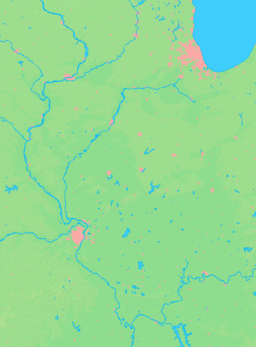Hinckley, Illinois
| Hinckley | |
| Village | |
| Country | United States |
|---|---|
| State | Illinois |
| County | DeKalb |
| Township | Squaw Grove |
| Coordinates | 41°46′17″N 88°38′26″W / 41.77139°N 88.64056°WCoordinates: 41°46′17″N 88°38′26″W / 41.77139°N 88.64056°W |
| Area | 0.85 sq mi (2 km2) |
| - land | 0.84 sq mi (2 km2) |
| - water | 0.01 sq mi (0 km2) |
| Population | 2,070 (2010) |
| Density | 2,100.7/sq mi (811/km2) |
| Timezone | CST (UTC-6) |
| - summer (DST) | CDT (UTC-5) |
| Postal code | 60520 |
| Area code | 815 |
  Location of Hinckley within Illinois | |
| Wikimedia Commons: Hinckley, Illinois | |
Hinckley is a village in Squaw Grove Township, DeKalb County, Illinois, United States. The population was 2,070 at the 2010 census, up from 1,994 in 2000.
History
The Village of Hinckley has a memorable history. In the 1830s, a Mr. Hollenbeck (who lived near Ottawa) was traveling the then-unsettled territory. He found a fine grove of trees west of the present-day Hinckley, and named the grove after the Native American women who were tending camp.
Back in Ottawa, word spread of the undeveloped land, and in the spring of 1835, John Sebree built a log house. The next year saw more families come to the area and soon a small town was started at the west edge of what is now Hinckley. The town's name was Squaw Grove.
Hinckley was conceived in the 1870s as the brainchild of Francis Hinckley, president of the Chicago and Iowa Railroad. The rail line was placed one-half mile east of the Village of Squaw Grove, which was then named Hinckley.
From this early birth, much change and innovation would come to Hinckley. Some key dates follow: Methodist Church (1835), first store (1872), Hinckley has 20 businesses (1876), St. Paul's Church (1885), volunteer fire brigade organized (1886), tornado destroys most of village (1889).
On January 7, 1927, the Harlem Globetrotters played their first road game in Hinckley before a crowd of 300.
Schools
Hinckley-Big Rock Community Unit School District #429 operates 3 schools.
Hinckley-Big Rock Elementary School is located on the westside of Hinckley on US HWY 30.
Hinckley-Big Rock Middle School is located in the center of Big Rock on US HWY 30.
Hinckley-Big Rock High School is located on the eastside of Hinckley on US HWY 30.
Geography
Hinckley is located at 41°46′17″N 88°38′26″W / 41.77139°N 88.64056°W (41.771389, -88.640526).[1]
According to the 2010 census, Hinckley has a total area of 0.848 square miles (2.20 km2), of which 0.84 square miles (2.18 km2) (or 99.06%) is land and 0.008 square miles (0.02 km2) (or 0.94%) is water.[2]
Demographics
| Historical population | |||
|---|---|---|---|
| Census | Pop. | %± | |
| 1880 | 368 | — | |
| 1890 | 496 | 34.8% | |
| 1900 | 587 | 18.3% | |
| 1910 | 661 | 12.6% | |
| 1920 | 665 | 0.6% | |
| 1930 | 626 | −5.9% | |
| 1940 | 710 | 13.4% | |
| 1950 | 774 | 9.0% | |
| 1960 | 940 | 21.4% | |
| 1970 | 1,053 | 12.0% | |
| 1980 | 1,447 | 37.4% | |
| 1990 | 1,682 | 16.2% | |
| 2000 | 1,994 | 18.5% | |
| 2010 | 2,070 | 3.8% | |
| Est. 2015 | 2,058 | [3] | −0.6% |
As of the census[5] of 2000, there were 1,994 people, 730 households, and 556 families residing in the village. The population density was 2,100.7 people per square mile (810.4/km²). There were 761 housing units at an average density of 801.7 per square mile (309.3/km²). The racial makeup of the village was 90.69% White, 1.80% African American, 0.20% Native American, 1.30% Asian, 0.60% from other races, and 1.10% from two or more races. Hispanic or Latino of any race were 5.51% of the population.
There were 730 households out of which 38.9% had children under the age of 18 living with them, 65.8% were married couples living together, 7.3% had a female householder with no husband present, and 23.8% were non-nuclear families. 18.6% of all households were made up of individuals and 7.5% had someone living alone who was 65 years of age or older. The average household size was 2.73 and the average family size was 3.14.
In the village the population was spread out with 28.9% under the age of 18, 6.6% from 18 to 24, 33.5% from 25 to 44, 21.2% from 45 to 64, and 9.8% who were 65 years of age or older. The median age was 35 years. For every 100 females there were 99.2 males. For every 100 females age 18 and over, there were 95.2 males.
The median income for a household in the village was $58,043, and the median income for a family was $65,726. Males had a median income of $45,179 versus $27,500 for females. The per capita income for the village was $23,491. About 3.8% of families and 4.4% of the population were below the poverty line, including 5.0% of those under age 18 and 5.1% of those age 65 or over.
Historical highlights
Hinckley was home to the first Harlem Globetrotters away game on January 7, 1927.[6]
In 1981, Hinckley served as stand-in for fictional North Crawford in Jonathan Demme's film adaptation of Who Am I This Time? by Kurt Vonnegut, Jr..[7] Christopher Walken and Susan Sarandon portray two painfully shy people who find one another through a community theater production of "A Streetcar Named Desire", in which they portray the tempestuous Stanley and Stella Kowalski.
Notes
- ↑ "US Gazetteer files: 2010, 2000, and 1990". United States Census Bureau. 2011-02-12. Retrieved 2011-04-23.
- ↑ "G001 - Geographic Identifiers - 2010 Census Summary File 1". United States Census Bureau. Retrieved 2015-08-03.
- ↑ "Annual Estimates of the Resident Population for Incorporated Places: April 1, 2010 to July 1, 2015". Retrieved July 2, 2016.
- ↑ "Census of Population and Housing". Census.gov. Archived from the original on May 11, 2015. Retrieved June 4, 2015.
- ↑ "American FactFinder". United States Census Bureau. Retrieved 2008-01-31.
- ↑ http://www.harlemglobetrotters.com/history/1927-team-now-officially-harlem-new-york-globetrotters
- ↑ End credits, home video release, MontereyMedia.com
External links
- Village of Hinckley
- Hinckley-Big Rock CUSD 429
- Hinckley Fire Protection District
- Squaw Grove Public Library